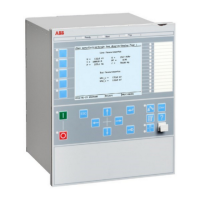1. Connect voltages to the IED according to valid connection diagram and figure
48.
2. Set Ur (rated voltage) to the
U1 inputs and increase U2 voltage until
differential voltage is 1.5 · operating level (UDTrip).
3. Switch on the test set. Measure the time from activation of the START signal
until TRIP signal is activated.
4. Check the measured time by comparing it to the set trip time tTrip.
5. Increase the voltage until START signal resets. Measure the time from reset
of START signal to reset of TRIP signal.
6. Check the measured time by comparing it to the set trip reset time tReset.
11.6.5.4 Final adjustment of compensation for VT ratio differences
SEMOD175258-183 v2
Procedure
1. With the protection in test mode, view the differential voltage service values
in each phase on the local HMI under Main menu/Test/Function status/
Voltage protection/VoltageDiff(PTOV,60)/VDCPTOV:x.
The IED voltage inputs should be connected to the VTs
according to valid connection diagram.
2. Record the differential voltages.
3. Calculate the compensation factor RFLx
for each phase.
For information about calculation of the compensation factor, see the
application manual.
4. Set the compensation factors on the local HMI under Main menu/Settings/
Settings group N/Voltage protection/VoltageDiff(PTOV,60)/VDCPTOV:x
5. Check that the differential voltages are close to zero.
11.6.5.5 Completing the test
SEMOD175258-208 v2
Continue to test another function or end the test by changing the TESTMODE
setting to Off. Restore connections and settings to their original values, if they were
changed for testing purposes.
11.6.6 Loss of voltage check LOVPTUV
SEMOD175023-3 v5
Prepare the IED for verification of settings outlined in Section
"Preparing the IED
to verify settings".
11.6.6.1 Measuring the
operate limit of set values
SEMOD175023-7 v7
1MRK 505 378-UEN A Section 11
Testing functionality by secondary injection
Line differential protection RED670 2.2 IEC 205
Commissioning manual

